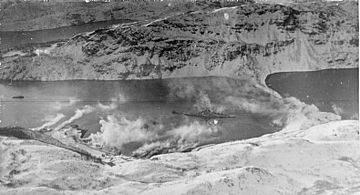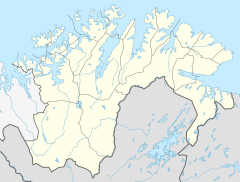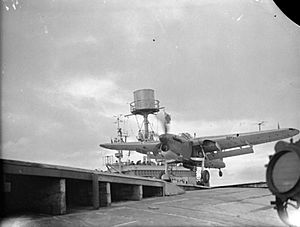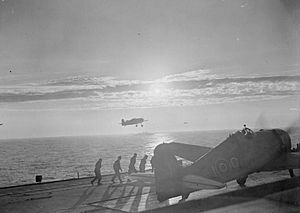Operation Mascot facts for kids
Quick facts for kids Operation Mascot |
|||||||
|---|---|---|---|---|---|---|---|
| Part of World War II | |||||||
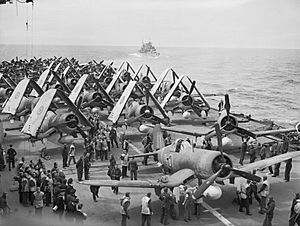 Corsair fighters and Barracuda bombers on the flight deck of HMS Formidable during operations off Norway in July 1944 |
|||||||
|
|||||||
| Belligerents | |||||||
| Commanders and leaders | |||||||
| Strength | |||||||
| 44 dive bombers 40 fighters |
One battleship Anti-aircraft batteries and ships |
||||||
| Casualties and losses | |||||||
| Three aircraft | One patrol craft 2 U-boats sunk |
||||||
Operation Mascot was a British air attack during World War II. It happened on July 17, 1944. The goal was to sink the huge German battleship Tirpitz. This ship was hiding in a place called Kaafjord, Norway.
The attack was not successful. British planes tried to bomb Tirpitz from aircraft carriers. This was one of many attempts to destroy the battleship. The British launched this attack because they learned that Tirpitz had been repaired after an earlier attack in April 1944.
A large group of 44 British dive bombers and 40 fighter planes took off early on July 17. German radar spotted them as they flew towards Kaafjord. By the time the planes arrived, Tirpitz was hidden by a thick smoke screen. Most British pilots could not see the battleship. Their bombs did not cause any serious damage.
Germany lost only one small patrol boat. The British lost three aircraft due to Kaafjord's defenses. Later, German submarines tried to attack the British carrier force. British patrol planes stopped them. Two German submarines were sunk, and several others were damaged.
In August 1944, the Royal Navy tried again with Operation Goodwood. These attacks also failed. The job of sinking Tirpitz was then given to the Royal Air Force.
Contents
Why Attack Tirpitz?
From early 1942, the German battleship Tirpitz was a big threat. It could attack Allied convoys. These convoys carried important supplies to the Soviet Union. Tirpitz was based in fjords along the Norwegian coast. It was powerful enough to destroy the ships protecting the convoys. To stop this, the Allies had to keep many warships with the British Home Fleet.
There were several attacks on Tirpitz in 1942 and 1943. On March 6, 1942, torpedo bombers from HMS Victorious attacked Tirpitz. They missed the ship. Land-based bombers from the RAF and Soviet air forces also tried to hit Tirpitz. They never caused any damage.
On September 23, 1943, something different happened. Two British midget submarines got past the defenses at Kaafjord. This was part of Operation Source. They placed explosives under Tirpitz. This attack caused a lot of damage. Tirpitz was out of action for six months.
The British still saw Tirpitz as a major danger. They wanted to destroy it before it could fight again. Another midget submarine attack was too risky. The RAF's bomber commander thought heavy bomber raids would fail. So, aircraft carriers were chosen as the best way to attack Kaafjord.
The first carrier attack, Operation Tungsten, happened on April 3, 1944. Five aircraft carriers took part. Two groups of 20 Fairey Barracuda dive bombers, with 40 fighters, flew to Kaafjord. They were not detected. Tirpitz was hit by 15 bombs. Many of her crew were hurt. The ship itself was not badly damaged. But the damage to its upper parts and engines kept it out of service for months.
The German navy commander, Grand Admiral Karl Dönitz, wanted Tirpitz repaired quickly. He knew it could no longer attack convoys. But it still tied up Allied naval forces.
British intelligence thought Tirpitz could be fixed in six months. The British navy ordered more carrier attacks. First Sea Lord Andrew Cunningham believed these attacks would keep Tirpitz out of action. He also hoped it would lower the crew's spirits.
The commander of the Home Fleet, Vice Admiral Bruce Fraser, was not sure. He thought more raids would fail. Tirpitz's defenses would be stronger. The weather might be worse. After some discussion, Fraser agreed to attack again. Many experienced airmen had left the Home Fleet. This made new operations harder.
Three planned raids in April and May 1944 were cancelled. Bad weather stopped them. For example, Operation Planet was called off on April 24. Fog covered the target area. Instead, the fleet attacked a German convoy. They sank three merchant ships. Operation Brawn in mid-May also faced heavy clouds. The planes returned without attacking. Operation Tiger Claw in late May was also cancelled due to bad weather. Instead, the carriers sank four merchant ships near Ålesund. No attacks happened in June. The Home Fleet ships were needed to support the Normandy landings in France.
Planning the Attack
Even after many failures, the British navy wanted to keep attacking Tirpitz. Admiral Sir Henry Moore took command of the Home Fleet on June 14, 1944. During June, the British received reports. These reports said Tirpitz's repairs were going well. The battleship would soon be ready to sail.
Later that month, spies saw Tirpitz testing its engines in Kaafjord. They reported it could sail at 20 knots (37 km/h). Its main guns could also turn. Because of this, the British decided to launch another carrier raid in mid-July. This attack would happen before the Arctic convoys started again. Convoys had stopped since April to free up ships for the invasion of France.
As the British found out, Tirpitz's repairs after Operation Tungsten were very fast. Work started in late April. 157 shipyard workers and special tools came from Kiel, Germany. They worked quickly. Three shifts of people worked on Tirpitz every day. This was helped by the long hours of daylight in Kaafjord during summer. By June 2, the battleship could move on its own. By the end of June, it was ready for gun practice. Repairs finished in mid-July. However, the ship's right propeller shaft could only move it forward. Captain Wolf Junge took command of Tirpitz in May 1944. He replaced Captain Hans Meyer, who was hurt during Operation Tungsten.
Ships and Planes Involved
For Operation Mascot, the British used three aircraft carriers. These were the new HMS Indefatigable, and the experienced Formidable and Furious. The carrier HMS Victorious had been sent to the Indian Ocean.
Other ships protected the carriers. These included the battleship HMS Duke of York, four cruisers, and twelve destroyers. Admiral Moore led the force from Duke of York. Rear Admiral Rhoderick McGrigor led the carrier group from Indefatigable.
The aircraft used were similar to earlier attacks. Formidable carried 24 Barracuda dive bombers and 18 Corsair fighters. Indefatigable had 24 Barracuda dive bombers. It also carried Supermarine Seafire and Fairey Firefly fighters. Furious did not have Barracudas this time. Instead, it carried 20 Grumman F6F Hellcat fighters. It also had three Seafires and three Fairey Swordfish anti-submarine planes.
Tirpitz's defenses were much better after Operation Tungsten. Before, there were eleven anti-aircraft gun batteries. There were also anti-aircraft warships and smoke generators. These could hide Tirpitz from planes. After the attack, more radar stations and observation posts were added. The number of smoke generators around the battleship increased.
By Operation Mascot, the defenses included a cliff-top observation post. This post could direct Tirpitzs anti-aircraft guns. Tirpitzs own air defenses were also stronger. More 20 mm cannons were added. Her 150 mm guns were changed to fire at planes. Her huge 380 mm main guns also had anti-aircraft shells.
Besides the forces near Kaafjord, Germany had twelve submarines. They formed Group Trutz near Jan Mayen island. Their job was to stop any British carrier forces. The German Luftwaffe (air force) had few fighters near Kaafjord. They also lacked fuel.
The Attack Begins
Rear Admiral McGrigor gave orders for Operation Mascot on July 4. He gave more detailed plans eight days later. The air squadrons practiced from their ships and bases. British intelligence got more information in early July. Photos from an RAF plane on July 12 showed Tirpitz was fully ready. The airmen learned on July 13 that they would attack Kaafjord in four days.
The British fleet left Scapa Flow on July 14. During the trip, the airmen learned about the attack plans. They also got escape kits in case they were shot down. Maintenance crews worked to get as many planes ready as possible. The German submarines in the Norwegian Sea did not find the British fleet. The weather was foggy for most of the trip. But the skies were clear on the evening of July 16. The fleet reached its launch position north of Kaafjord.
The carriers started launching planes just after midnight on July 17. The main attack force had 44 Barracudas. Most of these dive bombers carried powerful 1,600 lb (726 kg) armor-piercing bombs. A few carried three 500 lb (227 kg) bombs. 18 Corsairs were there to protect against German fighters. 20 Hellcats and 12 Fireflies were to attack anti-aircraft guns.
The bombers and fighters flew towards Kaafjord at 01:35. The planes flew very low, about 50 feet (15 m) above the sea. This was to avoid German radar. Ten minutes from the Norwegian coast, the Barracudas climbed to 9,000 feet (2,700 m). The fighters climbed even higher. The weather was good during the flight. But clouds appeared as they neared the target.
German radar stations spotted the British planes at 02:00. They were 43 miles (69 km) from Kaafjord. It took four minutes to warn Tirpitz. By 02:13, her smoke generators were working. They quickly covered the ship in an artificial cloud. Tirpitz and shore anti-aircraft guns started firing at 02:19. German forces also started jamming the British planes' radios. This happened when the planes were 10 miles (16 km) from the coast. The smoke screen made the British attack very difficult. Only two Barracudas and two fighters managed to see Tirpitz.
The Hellcats and Fireflies attacked first. They fired at anti-aircraft positions. They also attacked the destroyer Z33 and a small patrol boat, Vp 6307. The patrol boat was forced ashore and destroyed. The fighter pilots could only find targets by aiming at the flashes of tracer gunfire.
The Barracudas faced heavy anti-aircraft fire. But the German aim was not good. Only two planes saw Tirpitz. The other 35 dive bombers had to aim at the gun flashes. These bombing runs took 25 minutes. Seven bombs landed close to Tirpitz. But no damage was done to the battleship. One Barracuda attacked an anti-aircraft battery. Another tried to bomb a destroyer. A third nearly hit the tanker Nordmark. Three other Barracudas found no targets and dropped their bombs into the sea. One plane could not drop its bombs due to a faulty release.
German gunners fired many anti-aircraft shells. But they did not hit much. Only one British plane, a Corsair, was shot down near Kaafjord. Its pilot survived and was captured. A damaged Barracuda had to land in the water near Indefatigable. Its crew was rescued by the destroyer HMS Verulam. Several other Barracudas and five Hellcats were damaged. They returned to their carriers. One damaged Hellcat was later scrapped.
A second British raid was planned for 08:00 on July 17. But it was cancelled just before launch. Fog started to build up near the carriers. The British fleet then turned south to return to Scapa Flow. Swordfish and Seafire planes flew patrols over the Home Fleet all morning.
Submarine Battles
While Kaafjord was under attack, German submarine commanders gave new orders. Group Trutz submarines were to move south-east of Jan Mayen. They would try to stop the British ships returning to Scapa Flow. The British navy had expected this. So, patrol planes from No. 18 Group RAF were sent to sweep the Home Fleet's route.
The British patrol planes stopped Group Trutz from attacking the Home Fleet. At 21:48 on July 17, a Consolidated B-24 Liberator from No. 86 Squadron found and sank U-361. None of the submarine's crew survived. Eight minutes later, a Catalina flying boat from No. 210 Squadron spotted U-347 on the surface. The submarine's anti-aircraft guns hit the Catalina. The navigator was killed. The pilot, Flying Officer John Cruickshank, and three others were wounded. But Cruickshank continued his attack. He sank U-347 with depth charges. The Catalina managed to return to base. Cruickshank was awarded the Victoria Cross for his bravery. That night, the Home Fleet sailed through the gap created by the sinking of the two submarines.
Attacks on German submarines continued for six more days. On the morning of July 18, a German plane spotted the Home Fleet. But German Naval Command thought it was heading north-east for another attack. So, Group Trutz was ordered north. Four more submarines left Narvik to guard the approaches to Alten and Vest fjords. In the evening, U-968, one of the four submarines from Narvik, was attacked twice by Liberators. It shot down the first attacker. But the second damaged it, and it had to return to port. U-716 was also badly damaged by a Liberator attack at 19:15 on July 18. It managed to return to Hammerfest. Around 23:00 that day, U-716 was seriously damaged by a Short Sunderland but also survived. Three other submarines were attacked on July 20. Only one was damaged. After these events, the German submarine commander decided to break up Group Trutz. It was too easy for planes to attack. All but four surviving submarines returned to port. The rest were ordered to sail north, out of range of British planes. The last attack on a former Group Trutz submarine was on July 23. A No. 330 Squadron Sunderland damaged U-992 near Vestfjord.
What Happened Next?
After the July 17 attack, the British learned that Tirpitz had not been seriously damaged. This came from intercepted German radio messages and spy reports. Admiral Moore blamed the failure on the aircrew's lack of experience. He also criticized the attack leader for not choosing other targets. Moore believed that more attacks using Barracudas would be useless. These dive bombers were too slow. The Germans had enough time to cover Tirpitz with smoke once the raids were detected.
The British navy still hoped to wear down the defenses. They thought repeated attacks over 48 hours might work. Moore agreed to try another attack. They also thought about using fast, long-range de Havilland Mosquito bombers from the carriers. This might achieve surprise. But these land-based planes were needed for bombing Germany.
The next attack on Kaafjord happened in late August. This was Operation Goodwood. Planes from three fleet carriers and two escort carriers launched four raids. This happened between August 22 and 29. Each time, Tirpitz was covered in smoke. The attackers only caused light damage to the battleship. These failed attacks cost the British 17 aircraft and 40 airmen. The frigate HMS Bickerton was sunk by the submarine U-354. This same submarine also heavily damaged the escort carrier Nabob. Later, a British plane destroyed U-354.
After Operation Goodwood failed, the British navy accepted that Barracudas were too slow. They were not effective against the Kaafjord area. So, the job of attacking Tirpitz was given to RAF Bomber Command. The first heavy bomber raid on Kaafjord (Operation Paravane) happened on September 15, 1944. The bombers flew from bases in northern Russia. This attack caused damage to Tirpitz that could not be repaired.
Tirpitz was then moved south to the Tromsø area. It was used as a coastal defense battery, unable to move. On November 12, another Bomber Command raid (Operation Catechism) sank the battleship. Many lives were lost.


